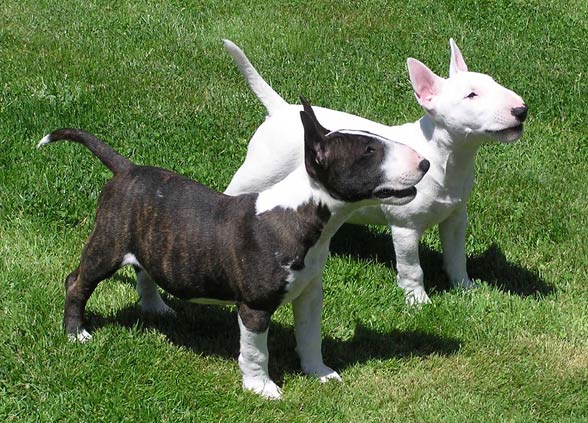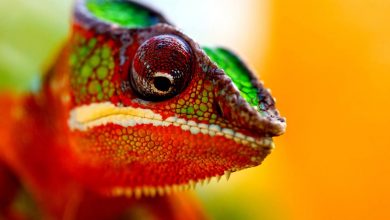Bull Terrier
Bull Terrier’s ancestors had checked the bloody sports and were more useful in catching garden pests. Today it is a bit calmer, but wild instincts wake up sometimes at inopportune moments. Bull Terrier is a dog, which needs a serious, mature owner to curb his – not always safe – aspirations.
Classification and standards
- FCI: Group 3 Section 3 #11
- AKC: Terrier
- ANKC: Group 2 (Terriers)
- CKC: Group 4 – Terriers
- KC (UK): Terrier
- NZKC: Terrier
- UKC: Terriers

History of the breed
Early in the mid-19th century, the “Bull and Terrier” breeds were developed to satisfy the needs for vermin control and animal-based blood sports. The “Bull and Terriers” were based on the Old English Bulldog (now extinct) and one or more of Old English Terrier and “Black and tan terrier”, now known as Manchester Terrier. This new breed combined the speed and dexterity of lightly built terriers with the dour tenacity of the Bulldog, which was a poor performer in most combat situations, having been bred almost exclusively for fighting bulls and bears tied to a post.
Many breeders began to breed bulldogs with terriers, arguing that such a mixture enhances the quality of fighting. Despite the fact that a cross between a bulldog and a terrier was of high value, very little or nothing was done to preserve the breed in its original form. Due to the lack of breed standards—breeding was for performance, not appearance—the “Bull and Terrier” eventually divided into the ancestors of “Bull Terriers” and “Staffordshire Bull Terriers”, both smaller and easier to handle than the progenitor.
About 1850, James Hinks started breeding “Bull and Terriers” with “English White Terriers” (now extinct), looking for a cleaner appearance with better legs and nicer head. In 1862, Hinks entered a bitch called “Puss” sired by his white Bulldog called “Madman” into the Bull Terrier Class at the dog show held at the Cremorne Gardens in Chelsea. Originally known as the “Hinks Breed” and “The White Cavalier”, these dogs did not yet have the now-familiar “egg face”, but kept the stop in the skull profile.

The dog was immediately popular and breeding continued, using Dalmatian, Greyhound, Spanish Pointer, Foxhound and Whippet to increase elegance and agility; and Borzoi and Collie to reduce the stop. Hinks wanted his dogs white and bred specifically for this. Generally, however, breeding was aimed at increasing sturdiness: three “subtypes” were recognized by judges, Bulldog, Terrier and Dalmatian, each with its specific conformation, and a balance is now sought between the three. The first modern Bull Terrier is now recognized as “Lord Gladiator”, from 1917, being the first dog with no stop at all.
Due to medical problems associated with all-white breeding, Ted Lyon among others began introducing color, using Staffordshire Bull Terriers in the early 20th century. Coloured Bull Terriers were recognized as a separate variety (at least by the AKC) in 1936. Brindle is the preferred color, but other colors are welcome.
Along with conformation, specific behavior traits were sought. The epithet “White cavalier”, harking back to an age of chivalry, was bestowed on a breed which while never seeking to start a fight was well able to finish one, while socializing well with its “pack”, including children and pups. Hinks himself had always aimed at a “gentleman’s companion” dog rather than a pit-fighter—though Bullies were often entered in the pits, with some success.

Appearance
The Bull Terrier’s most recognizable feature is its head, described as ‘egg-shaped’ when viewed from the front, the top of the skull is almost flat from ear to ear. Profile curves gently downwards from the top of the skull to tip of nose which should be black and bent downwards at tip. Nostrils are well developed and under-jaw deep and strong snout.
The unique triangle-shaped eyes are small, dark, and deep-set. The body is full and round, while the shoulders are robust and very muscular and the tail is carried horizontally. They are generally white in color, walk with a jaunty gait, and are popularly known as the ‘Gladiator of the canine race’.

Temperament
Bull Terriers are known to be courageous, playful, and active. They enjoy being around people but are strong willed and thus require an assertive owner; as such the Bull Terrier is not recommended for households with small children if the owner is a first time Bull Terrier owner. Bull Terriers are affectionate and need the companionship of their owners and should not be kept outside in a kennel.
Bull Terriers can be both independent and stubborn and for this reason, are not considered suitable for an inexperienced dog owner. They are protective of their family, although comprehensive socialization at an early age will prevent them from becoming over-protective and neurotic.
Bull Terriers have a strong prey instinct and, like any strong dog breed, when unduly challenged may cause injury or death to other animals, especially cats. That said, puppies brought up with cats and other animals get on well with the animals they know. Early socialization will ensure that the dogs will get along with other dogs and animals.

Health
All puppies should be checked for deafness, which occurs in 20% of pure white dogs and 1.3% of dogs and is difficult to notice, especially in a relatively young puppy. Many Bull Terriers have a tendency to develop skin allergies. Insect bites, such as those from fleas, and sometimes mosquitoes and mites, can produce a generalized allergic response of hives, rash, and itching.
This problem can be stopped by keeping the dog free of contact from these insects, but this is definitely a consideration in climates or circumstances where exposure to these insects is inevitable. A UK breed survey puts their median lifespan at 10 years and their mean at 9 years, with a good number of dogs living to 10–15 years.

Data / size
- Weight: Males: 22–38 kg (50–85 lbs)
- Height: Males: 45–55 cm (18–22 in)
- Coat: Short, dense
- Litter size: up to 13
- Life span: 9–12 years

Bull Terrier – interesting facts
- Due to health problems occurring virtually in all white bull terriers, Ted Lyod introduced color to the breed, using Staffordshire bull terriers in the early 20th century. Colored bull terriers were recognized as a separate variety in 1936.
- Bull Terriers are called “Gladiators of dogs”.
- In addition to standard bull terriers, there is also its miniature counterpart – miniature bull terrier.



















kidney failure. Must be noted as an issue with this breed
Thank you for your supplement.